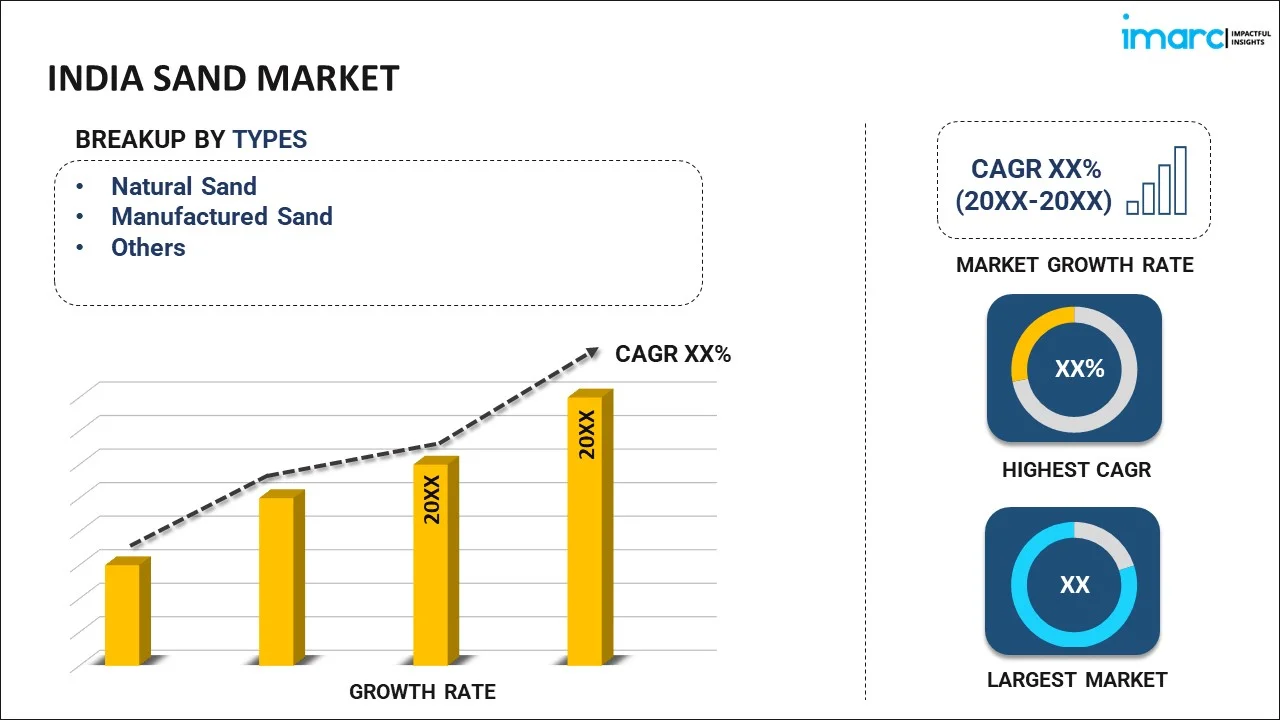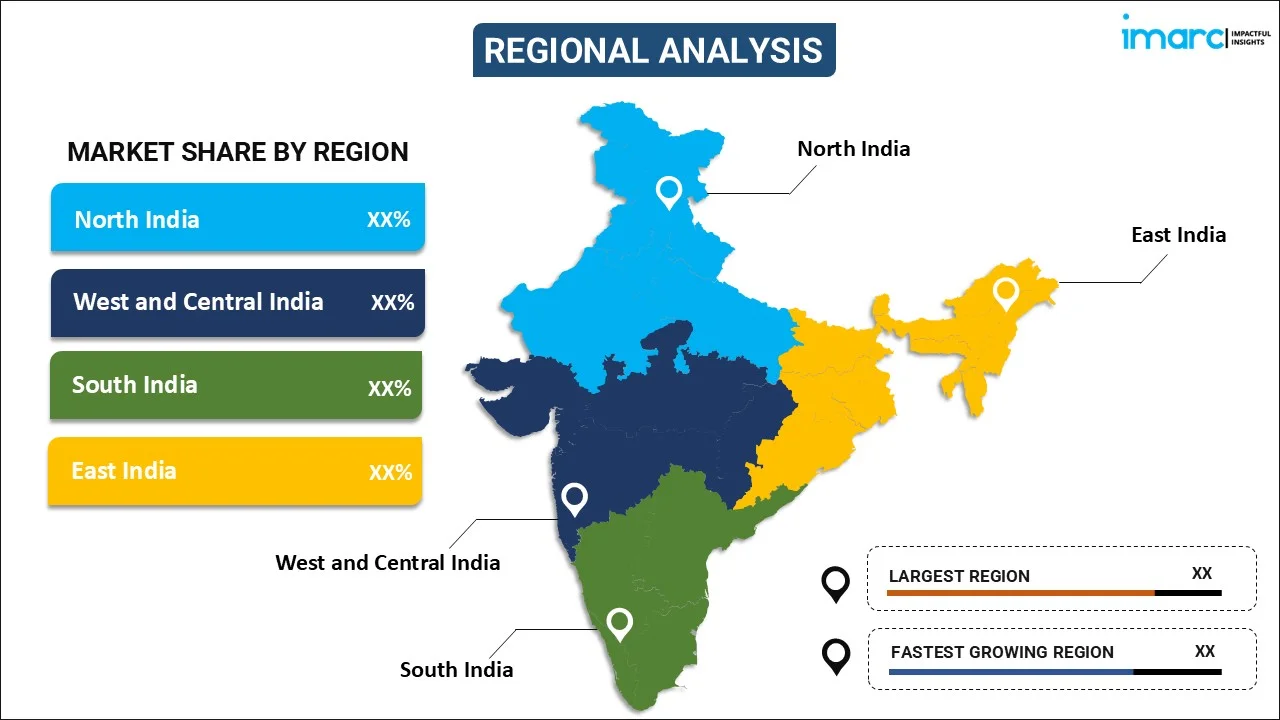
India Sand Market Report by Type (Natural Sand, Manufactured Sand, and Others), Application (Industrial, Commercial, Residential, Infrastructure), and Region 2025-2033
Market Overview:
The India sand market size reached USD 582.6 Million in 2024. Looking forward, IMARC Group expects the market to reach USD 958.0 Million by 2033, exhibiting a growth rate (CAGR) of 5.10% during 2025-2033.
|
Report Attribute
|
Key Statistics
|
|---|---|
|
Base Year
|
2024
|
|
Forecast Years
|
2025-2033
|
|
Historical Years
|
2019-2024
|
|
Market Size in 2024
|
USD 582.6 Million |
|
Market Forecast in 2033
|
USD 958.0 Million |
| Market Growth Rate 2025-2033 | 5.10% |
Sand refers to a cluster of fine rock particles composed of numerous minerals, primarily quartz and feldspar fragments and small fossil fragments. It is formed by the weathering and erosion of inland and marine rock particles, bio-organisms and organic by-products. It is a natural resource that is found abundantly across ocean and sea beaches, riverbanks and riverbeds in varying sizes and compositions. The grain sizes of sand are finer than gravel but coarser than silt. In India, natural sand is commonly mined from waterbody beds, especially rivers, for industrial applications. It is extensively utilized for diverse applications in manufacturing, construction, flooring and home decoration.
India Sand Market Trends:
The market is primarily driven by the increasing product demand in the construction industry. This can be attributed to the expansion of the residential segment in India due to the rapid population shift in urban areas. Besides this, the growing environmental concerns regarding riverbed mining for natural sand have led to a higher uptake of manufactured sand, which, in turn, is creating a positive outlook for the market. Favorable government initiatives supporting the usage of manufactured sand over natural sand due to an enhanced focus on sustainable development are also providing an impetus to the market. In addition to this, the growing adoption of silica sand for manufacturing standard and specialty glasses is further providing a boost to the market across the country. Some of the other factors that are contributing to the market growth include the growing number of infrastructural development projects, the increasing utilization of silica sand for obtaining shale gas, and extensive research and development (R&D) activities conducted by key players.
Key Market Segmentation:
IMARC Group provides an analysis of the key trends in each sub-segment of the India sand market report, along with forecasts at the country and regional level from 2025-2033. Our report has categorized the market based on type and application.
Breakup by Type:

- Natural Sand
- Manufactured Sand
- Others
Breakup by Application:
- Industrial
- Commercial
- Residential
- Infrastructure
Breakup by Region:

- North India
- West and Central India
- South India
- East India
Competitive Landscape:
The competitive landscape of the industry has also been examined along with the profiles of the key players.
Report Coverage:
| Report Features | Details |
|---|---|
| Base Year of the Analysis | 2024 |
| Historical Period | 2019-2024 |
| Forecast Period | 2025-2033 |
| Units | Million USD |
| Segment Coverage | Type, Application, Region |
| Region Covered | North India, West and Central India, South India, East India |
| Customization Scope | 10% Free Customization |
| Post-Sale Analyst Support | 10-12 Weeks |
| Delivery Format | PDF and Excel through Email (We can also provide the editable version of the report in PPT/Word format on special request) |
Key Questions Answered in This Report
We expect the India sand market to exhibit a CAGR of 5.10% during 2025-2033.
The rising utilization of sand for diverse applications in manufacturing, construction, flooring, and home décor applications is primarily driving the India sand market.
The sudden outbreak of the COVID-19 pandemic had led to the implementation of stringent lockdown regulations across the nation resulting in the temporary halt in numerous construction activities, thereby limiting the demand for sand.
Based on the type, the India sand market can be segmented into natural sand, manufactured sand, and others. Currently, manufactured sand holds the majority of the total market share.
Based on the application, the India sand market has been categorized into industrial, commercial, residential, and infrastructure. Among these, the industrial sector currently accounts for the largest market share.
On a regional level, the market can be classified into North India, West and Central India, South India, and East India, where North India currently dominates the market.
Need more help?
- Speak to our experienced analysts for insights on the current market scenarios.
- Include additional segments and countries to customize the report as per your requirement.
- Gain an unparalleled competitive advantage in your domain by understanding how to utilize the report and positively impacting your operations and revenue.
- For further assistance, please connect with our analysts.
 Inquire Before Buying
Inquire Before Buying
 Speak to an Analyst
Speak to an Analyst
 Request Brochure
Request Brochure
 Request Customization
Request Customization




.webp)




.webp)












